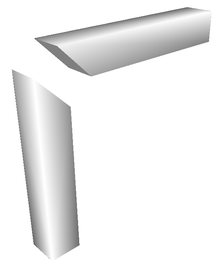Miter joint
A mitre joint (often miter in American English) is a joint made by cutting each of two parts to be joined, across the main surface, usually at a 45° angle, to form a corner, usually a 90° angle. It is called beveling when the angled cut is done on the side, although the resulting joint is still a mitre joint.[1]


For woodworking, a disadvantage of a mitre joint is its weakness, but it can be strengthened with a spline (a thin wafer of wood inserted into a slot, usually arranged with the long grain of the spline across the short grain of the frame timber).[2] There are two common variations of a splined mitre joint, one where the spline is long and runs the length of the mating surfaces and another where the spline is perpendicular to the joined edges.
Common applications include picture frames, pipes, and molding.
Non-perpendicular joints
For mitre joints occurring at angles other than 90°, for materials of the same cross-section the proper cut angle must be determined so that the two pieces to be joined meet flush (i.e. one piece's mitered end is not longer than the adjoining piece). To find the cut angle divide the angle at which the two pieces meet by two. Technically, two different cut angles are required; one for each piece, where the second angle is 90° plus the aforementioned cut angle, but due to angular limitations in common cutting implements (hand circular saws, table saws) a single angle is required and is used to cut the first piece in one direction and the second piece in the opposite direction.
Three-dimensional joints
When a piece is beveled at both ends, such that the two attached pieces do not lie in the same plane, a three-dimensional structure is obtained. In that case, it is also necessary either to rotate the piece in its longitudinal axis, or, to tilt the saw blade before beveling the second end.
When employing the miter joint to connect two pieces that have a non-circular cross-section it typically is desirable to have the longitudinal edges of the joined pieces match up properly at the joint. It is always possible to close a planar structure constructed with pieces having non-circular cross section into a loop through properly matched miter joints (e.g. a picture frame), however, a three-dimensional loop from pieces with non-circular cross section need not close properly when attempting to miter it all the way around. In general, a twist occurs, causing the edges at the last joint to be misaligned.
See also
- Mason's mitre
- Miter box
- Mitre clamp
- Miter saw
- Pipe notching
References
- Oxford English Dictionary. Oxford University Press. 2009.
A usually right-angled joint in wood or other material in which the angle made by the joined pieces is bisected by the line or plane of junction; more fully mitre joint
- "Splined Miter Joint". Woodworkingtips.com. Retrieved 2012-04-01.
Further reading
- Adamson, John, "The making of the mitre plane", Furniture & Cabinetmaking, issue 270, May 2018, pp. 44–9
External links
| Look up miter joint in Wiktionary, the free dictionary. |
- Miter Saw Calculator
- Verhoeff, Tom and Koos Verhoeff, PDF "The Mathematics of Mitering and Its Artful Application", Bridges Leeuwarden: Mathematical Connections in Art, Music, and Science, Proceedings of the Eleventh Annual Bridges Conference, in The Netherlands, pp. 225–234, July 2008.